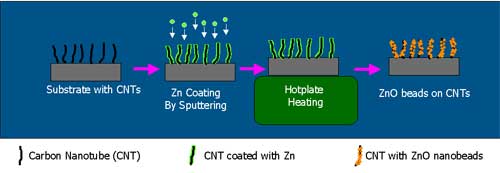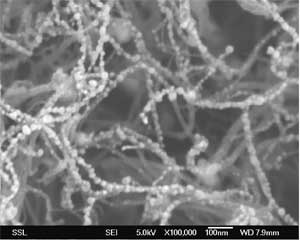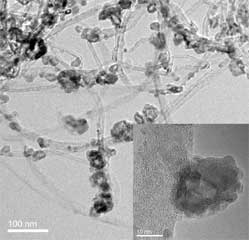| Posted: Mar 10, 2006 | |
Hybrid carbon nanotube material allows ultrafast nonlinear optical switching |
|
| (Nanowerk News) Nano Zinc Oxide (ZnO) and Carbon Nanotubes (CNTs) are arguably two of the most studied nanomaterials in recent years. Combining these two nanomaterials into hybrid nanomaterial presents a fascinating nanosystem for further investigations. | |
| Researchers in Singapore told Nanowerk how they developed a very simple technique to fabricate a hybrid nanomaterial system comprising of ZnO nanobeads anchored onto the cylindrical body of CNTs. | |
| "In our humble opinion" Professor Chorng-Haur Sow from the National University of Singapore says, "our results shed light on opportunities for integrating CNTs with functional oxide nanoparticles cost-effectively for future nanodevices." | |
| Sow and his colleagues report their work, titled "Multiwalled Carbon Nanotubes Beaded with ZnO Nanoparticles for Ultrafast Nonlinear Optical Switching" in the March 2, 2006 online edition of Advanced Materials. In their paper, the researchers detail the simple fabrication technique and characterizations of the hybrid nanomaterial system. | |
 | |
| Schematic of the processing steps for the fabrication of the hybrid ZnO-CNTs nanomaterials systems. This is achieved simply by heating Zn coated CNTs on a hotplate in air. (Source: National University of Singapore) | |
| The two important building blocks in nanotechnology, ZnO nanoparticles and CNTs, have rarely been assembled as hybrid structures. | |
| CNTs have been used as templates or scaffolds for the hybrid assembly of nanoparticles. Because of their great hardness and toughness, CNTs keep their morphology and structure even at high nanoparticle loadings. Using different methods, many types of metal and semiconductor nanoparticles have been assembled on CNTs. Recently, CNTs beaded with a variety of nanoparticles have been reported. More importantly, some of these beaded CNT hybrid systems exhibit unique properties. | |
| ZnO, on the other hand, has received widespread attention because of its excellent performance in electronics, optics, and photonics systems due to its importance as a wide-bandgap semiconductor with a large exciton binding energy. | |
| Sow explains to Nanowerk: "From the point of view of potential application, we found that this hybrid nanomaterial demonstrated nonlinear ultrafast optical response and the absorption is tunable by the amount of ZnO coating. | |
| "Such behavior reflects the intriguing interplay between the properties of ZnO and CNTs in this hybrid system." | |
  |
Left image: A typical scanning electron microscopy image of ZnO nanoparticles beaded CNTs; Right image: Transmission electron microscopy (TEM) image and high-resolution TEM image, showing the connection between ZnO and CNTs. (Source: National University of Singapore) |
| He adds: "Such integration could induce lots of novel or optimized properties. We feel that more experiments involving such hybrid nanomaterial can be carried out since they can be fabricated with ease. In addition, the feasibility of a simple and economical method for the fabrication of such hybrid nanomaterials system would be very attractive to the future application of nano hybrids." | |
 By
Michael
Berger
– Michael is author of three books by the Royal Society of Chemistry:
Nano-Society: Pushing the Boundaries of Technology,
Nanotechnology: The Future is Tiny, and
Nanoengineering: The Skills and Tools Making Technology Invisible
Copyright ©
Nanowerk LLC
By
Michael
Berger
– Michael is author of three books by the Royal Society of Chemistry:
Nano-Society: Pushing the Boundaries of Technology,
Nanotechnology: The Future is Tiny, and
Nanoengineering: The Skills and Tools Making Technology Invisible
Copyright ©
Nanowerk LLC
|
|
Become a Spotlight guest author! Join our large and growing group of guest contributors. Have you just published a scientific paper or have other exciting developments to share with the nanotechnology community? Here is how to publish on nanowerk.com.
